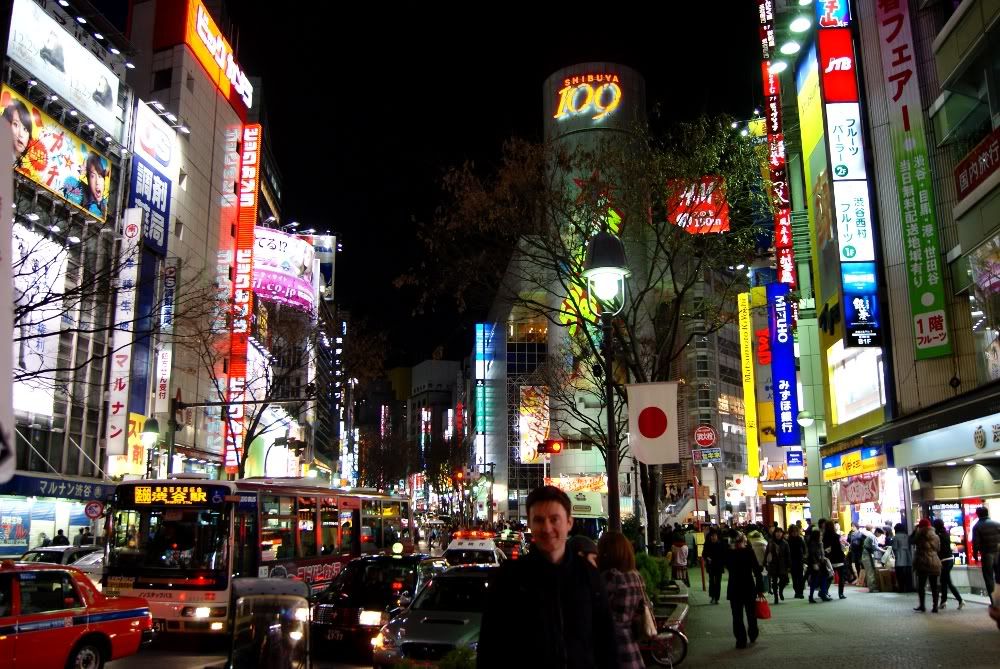
Having woken absurdly early, it was a perfect opportunity to visit the Tokyo Central Wholesale Market at Tsukiji, and so at 4:30am we caught a taxi down to the docks and walked through the dark into the busy warehouses – dodging motorised platforms, push trolleys laden with fish and men carrying gigantic boxes – to enjoy a cup of coffee in a labourers' cafe before inspecting the market proper.
At the back of the market, a closed-off building housed row upon row of headless tuna, laid out on blankets in the hangar like corpses recovered from a plane crash, eager buyers shining torches into the cavities before bidding in the auction. During the course of the first hour we saw the bodies being sold, being transported to retail stalls, being hacked into manageable chunks by men with giant swords, and being carved into precise rectangles by a woman at a bandsaw. Of course, we also then ultimately ate the stuff for breakfast. The Japanese seem to be obsessed with tuna, but of course there were hundreds of other types of fish and seafood to see, and a superb morning was spent inspecting the various species and enjoying the buzz of the market.
We had breakfast at Bentomi, a cramped sushi bar where you sit at the counter as the sushi chefs make the sushi to order, swiftly moulding the rice with one hand while taking a piece of fish and a fingertip of wasabi with the other, combining the three ingredients, compressing and plating it all up in the time it would take me to pour out a bowl of muesli. Behind in the kitchen you could see the freshly bought fish entering through the back door and being sliced into delicate slivers of fresh, sweet flesh before joining the sushi chef out front. It was again almost as good to watch as it was to eat.
After seeing the fishmongers reach the end of their working day, it was almost time for the office workers to start theirs. We took the tube to Shinjuku – the western business district – and enjoyed a cup of coffee and a stroll around the empty plazas before it turned 8:30, whereupon we were greeted by hordes of commuters as they poured out of Shinjuku station (apparently the busiest train station on Earth) and marched together through the streets to their office buildings, battering us out of the way as we fought against the flow.

It was still several hours before anything opened for the tourists, we walked to the nearby Shinjuku Gyoen National Garden for what we imagined would be a sedate stroll. In fact, the park was beautiful, and a happy hour was spent exploring the Japanese gardens with their bridges, ponds, friendly carp and - perhaps most of all - delicately trimmed trees, the topiarists still hard at work turning the bold and masculine firs into gentle floating clouds of leaves.
I has imagined Tokyo to be a forest of giant skycrapers – like Hong Kong without the crippling levels of poverty – but Shinjuku was a small orchard of sky scrapers at best. We travelled to the viewing platform at the top of one of the tallest - the Tokyo Municipal Hall - and while the city is certainly huge (stretching off into the horizon, only stopping when it reaches Mount Fuji), Tokyo was revealed to be mostly carpeted with low-rise buildings. It is only our second day in Tokyo, but the city already seems much smaller and more manageable than I had imagined before our arrival.
We walked to the Opera City for lunch and the ICC Inter-Communication Centre (an art gallery for technology-inspired art, although this turned out to mean exhibits comprising a Twitter search, a Google Image search and a series of poorly tuned radios), before it was midday and we needed our nap.

In the evening we took the tube out to to Shibuya, the teenage playground district which was like a souped-up Times Square, where the huge electronic adverts come with blaring sound and music too. We had a deep-fried supper at Tonkatsu Wako in Centre Gai, before deciding to call it a day.
Cultural aside: During the course of the day we also read about the lives of the average Tokyoite. It seems that Shibuya exists as a pleasure ground in which teenagers are encouraged to enjoy themselves as much as possible before they come of age and must embark on the severe responsibilities of adult life, at which point the women retreat to the home to serve as housewives while the men become commuters, working long hours, travelling at least two hours a day and hardly ever seeing their families again (we saw hundreds of these drab men, swaddled in identical grey suits and either napping on the tube or grimacing as they embraced their predetermined existence).
This extremely constrained life would appear to explain why a country with such great longevity and one of the oldest populations has such a teen-focussed economy, and why so many adult Japanese men seek to escape the drab uniformity of their lives through fantasy and computer games. My verdict is: thank goodness for feminism and the rise of the individual in the West.




No comments:
Post a Comment